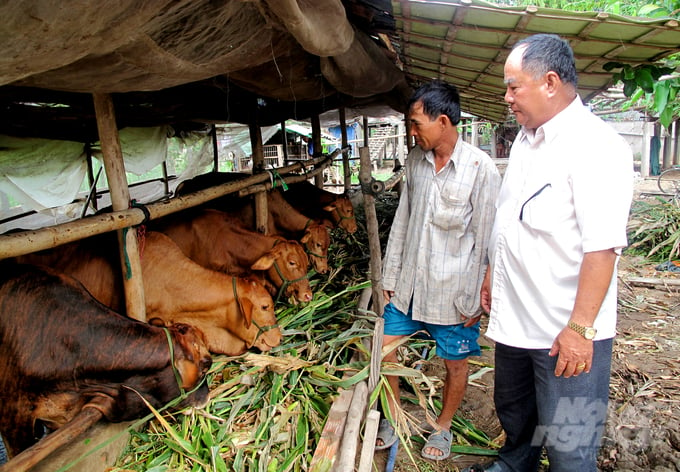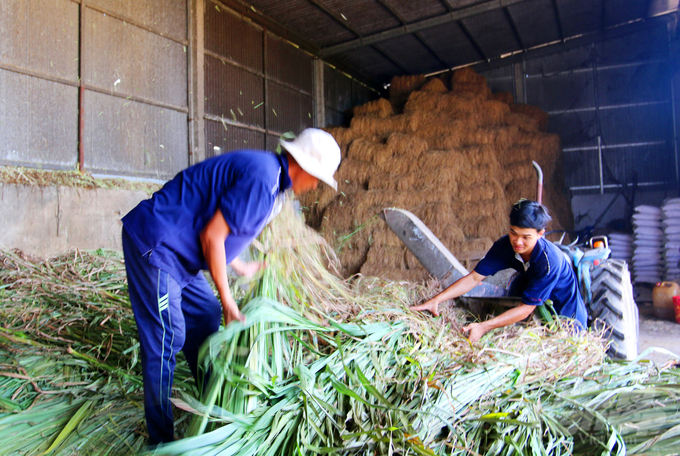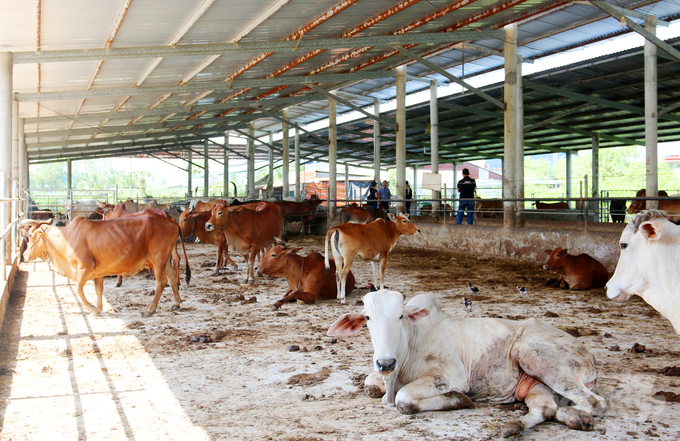May 24, 2025 | 16:22 GMT +7
May 24, 2025 | 16:22 GMT +7
Hotline: 0913.378.918
May 24, 2025 | 16:22 GMT +7
Hotline: 0913.378.918

The movement to raise beef cattle in Long An province has developed strongly in recent years. Photo: Le Hoang Vu.
In recent years, the movement to raise beef cattle in Long An province has been experiencing strong developments, especially in Duc Hoa and Duc Hue districts. Statistics show that the beef cattle herd of these two localities totals nearly 10,000 heads, accounting for 80% of the entire province’s total beef cattle herd.
Phan Van Ken's family is one of five households with the largest cattle fattening farm in Duc Lap Ha commune (Duc Hoa district). Raising beef cattle brings high profits and quick capital turnover time. Each batch of cattle only takes 3 - 4 months on average to be released to the market. HÍ family currently raises approximately 200 cows per batch. After deducting all costs such as breeding cows, labor, feed, veterinary drugs, he still gets a profit of nearly VND 1 billion.
Ken's family used to make a living by cultivating rice. Taking advantage of the grass around the shore, he raised a few cows to earn some chump change. Gradually realizing that cows were easy to raise and had a stable output, he decided to expand into farm-scale livestock production.
Particularly in 2019, Ken received active support from functional sectors, such as banks lending capital, the district Office of Agriculture and Rural Development and Long An Department of Agriculture and Rural Development providing technical assistance. As a result, he boldly changed from the traditional form of raising cows to high-tech cattle farming. Using this new method, the cows not only grew quickly but were also easy to sell because the model ensured food safety with no sign of antibiotic residues in the output.

Beef cattle have fresh grass as the main daily feed. Photo: Le Hoang Vu.
In the case of Pham Thanh Cong in Hoa Khanh Tay commune, Duc Hoa district, his family is also implementing a cattle fattening model, with a scale of approximately 200 cows. Cong applied for a VND 3 billion loan at Agribank to implement this model.
"We previously grew lemon in the garden but it turned out to be ineffective. Now we devote the whole land area to growing grass as daily feed for cows. I also rent more than 4 ha of land nearby to ensure there is a source of fresh feed for the cows to eat all year round,” said Cong. After each batch, he earns VND 600 million from selling beef cattle.
Many owners of large-scale beef farms believe that raising beef cattle is not difficult, because most farmers receive training and technical guidance from the local agricultural sector before implementing the model. The most worrisome thing is the relatively large initial investment. The price of each cow is up to several tens of millions of VND on average, and even more money is needed to build barns and buy machinery and equipment.

Phan Van Ken's beef farm profits nearly VND 1 billion each year. Photo: Le Hoang Vu.
Apart from large-scale beef farms, Duc Hoa and Duc Hue districts also develop household-based beef farming and participate in beef cattle cooperatives to receive support in terms of technical training, periodic vaccination, and especially output.
According to Vo Thanh Quang, Chairman of the Board of Directors cum Director of the beef cattle cooperative in Hoa Khanh Dong commune (Duc Hoa district), beef cattle farmers who feed them fully and comply with periodic vaccinations help their cows stay healthy and grow quickly, which brings high economic efficiency. The cattle fattening model in Hoa Khanh Dong commune has thus gradually become the main livestock model for many local farmers. Currently, the cooperative has 65 members raising nearly 220 cows.
“Beef cattle farming has helped many households inside and outside the cooperative earn high income and escape poverty. The cooperative has also been promoting effective models and encouraging people to raise cattle in the direction of ensuring farm sanitary, preventing diseases, and establishing consumption linkage. We hope to both ensure output and avoid the situation of being pressured by traders," said Chairman Vo Thanh Quang.
Based on the existing potential and advantages, Duc Hoa and Duc Hue districts aim to invest in building a concentrated beef cattle farming area applying high technology in the spirit of Resolution No. 08 of the Long An Provincial Party Committee on developing high-tech agriculture associated with agricultural restructuring.
Translated by Samuel Pham

(VAN) The People's Committee of Tra Vinh province has approved an adjustment to the investment policy for the Green Hydrogen Plant project, increasing its area to approximately 52.76 hectares.
![Reducing emissions from rice fields: [2] Farmers’ commitment to the soil](https://t.ex-cdn.com/nongnghiepmoitruong.vn/608w/files/news/2025/05/05/dsc08881jpg-nongnghiep-140632.jpg)
(VAN) Clean rice cultivation model in Thuong Tan commune, Bac Tan Uyen district, is assisting local residents in achieving sustainable agriculture by substantially reducing costs, increasing productivity, and protecting the environment.

(VAN) At the conference to disseminate Resolution No. 68, AgriS introduced its digital agricultural ecosystem and reaffirmed its commitment to accompanying the Government in promoting private sector development and sustainable agriculture.

(VAN) 'Blue Ocean - Blue Foods' initiative is designed to restore marine ecosystems and establish sustainable livelihoods for local communities by cultivating a minimum of 1,000 hectares of cottonii seaweed in the first three years.
/2025/05/21/4642-3-112707_603.jpg)
(VAN) The V-SCOPE project has made direct contributions to three out of six pillars of the Comprehensive Strategic Partnership between Vietnam and Australia.

(VAN) Facing the threat of rabies spreading to the community, Gia Lai province urgently carries out measures to vaccinate dogs and cats on a large scale.

(VAN) Disease-free livestock farming not only protects livestock herds but also stabilizes production and livelihoods for many farmers in Tuyen Quang.